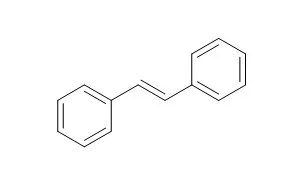| Structure Identification: |
| Macromolecular Chemistry & Physics, 1995, 196(6):1999-2009. | | Complex‐radical alternating terpolymerization of maleic anhydride, trans-stilbene and N-phenylmaleimide.[Reference: WebLink] |
METHODS AND RESULTS:
Radical terpolymerizations of maleci anhydride (MA), trans-Stilbene (Stb) and N-phenylmale-imide (PhMI) were carried out in methyl ethyl ketone (MEK) at 60-80 C in the presence of 2,2'-azoisobutyronitrile (AIBN) as initiator. The terpolymerization was evaluated by using either the free monomer or complex participation models. The relative of MA toward poly(Stb) radical was found to be about 10,6 times lower than that of PhMl. The initial rate of copolymerization, the participation of the charge transfer complex (CTC) monomers and free monomers was quantitatively estimated. It was established that, even with a considerable change in the ratio of electron-acceptor monomers (MA and PhMI) in the initial reaction mixture, terpolymers possessed always a composition ratio close to 1:2:1. Constants for copolymerization of MA-Stb (M1) and PhMI-Stb (M3) were determined by using the Kelen-Tudos equation, and r1 . K1/K3 = 0,03 and r2 . K3/1 =0,08, where K1 and K3 are complex-formation constants of MA-Stb and PhMl-Stb complexes, respectively, were obtained.
CONCLUSIONS:
The result of kinetic studies of terpolymerization was interpreted as involving mainly alternating copolymerization of two complexomers with predominant participation in chain growth. Thermogravimetric analyses indicated the high thermal stabilities of terpolymers obtained. | | Journal of Photochemistry & Photobiology A Chemistry, 1995, 85(3):225-229. | | Solid state photoaddition reactions in polycrystalline mixtures of NH heteroaromatic compounds and trans-stilbene.[Reference: WebLink] |
METHODS AND RESULTS:
Photoaddition reactions of indole ( 1a ), carbazole ( 1b ) and phenothiazine ( 1c ) to trans -stilbene ( 2 ) occurred in the mixed crystal state to give the corresponding adducts 3a , 3b and 3c with an N C bond. Photoadduct 4a with a C C bond was also obtained by the solid state photoreaction of 1a with 2 . The mixed crystals prepared by the melting and resolidifying method were simple polycrystalline mixtures of the two components, and the photoreactions proceeded at the interface of the two crystallites.
CONCLUSIONS:
The selectivity of the photoaddition reaction was higher in the solid state than in solution. |
|






 Cell. 2018 Jan 11;172(1-2):249-261.e12. doi: 10.1016/j.cell.2017.12.019.IF=36.216(2019)
Cell. 2018 Jan 11;172(1-2):249-261.e12. doi: 10.1016/j.cell.2017.12.019.IF=36.216(2019) Cell Metab. 2020 Mar 3;31(3):534-548.e5. doi: 10.1016/j.cmet.2020.01.002.IF=22.415(2019)
Cell Metab. 2020 Mar 3;31(3):534-548.e5. doi: 10.1016/j.cmet.2020.01.002.IF=22.415(2019) Mol Cell. 2017 Nov 16;68(4):673-685.e6. doi: 10.1016/j.molcel.2017.10.022.IF=14.548(2019)
Mol Cell. 2017 Nov 16;68(4):673-685.e6. doi: 10.1016/j.molcel.2017.10.022.IF=14.548(2019)